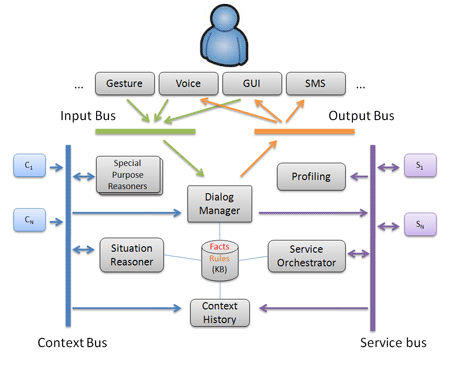The PERSONA project (Perceptive Spaces prOmoting iNdependent Aging) is an EU-funded research project (FP6) that commenced in 2007. It aims at developing a scalable open standard technological platform for building a broad range of Ambient Assisted Living (AAL) services. AAL is the concept that embraces all those technological challenges involved in addressing the problem of population aging in Europe.
The main technical challenge for PERSONA is the design of a self-organizing middleware infrastructure that guarantees the extensibility of component/ device ensembles in an ad-hoc fashion. In order to achieve this goal, the communication patterns of the infrastructure must be based on distributed coordination strategies for service discovery and utilization.
The components of a PERSONA system interact using the PERSONA middleware, which allocates a number of communication buses, each adopting specific and extensible communication strategies. Components linked to the PERSONA middleware may register with some of these communication buses; using P2P connections between the middleware instances, instances of the buses collaborate to enable interoperability among components. Currently four types of bus cover the high-level communication needs in AAL spaces: the input bus, the output bus, the context bus and the services bus.
PERSONA uses a connector-based approach to implement an extensible communication mechanism between distributed instances of the middleware (peers). The current prototype of the PERSONA middleware implemented on the OSGi platform (see Figure 1) uses connectors based on UPnP, Bluetooth and R-OSGi technologies.

Figure 2 outlines the conceptual architecture of PERSONA with its bus system and shows some of the platform components necessary for constructing AAL services. They are derived from a thorough analysis of different PERSONA scenarios in a set of crucial sectors: social integration, daily activities, safety and mobility (see http://www.aal-persona.org/scenarios.html).

As can be seen in Figure 2, the multimodal input processing components that register with the input bus capture user utterances and publish their interpretation of explicit user input to the system. Similarly, output-processing components register with the output bus in order to present system output to the user. The context bus is also an event-based bus, to which context sources are attached; the events generated may be reprocessed and transformed into high-level events (situations) by components subscribed to the bus (eg context reasoners). The service bus facilitates access to all the services available in AAL spaces. These services can be atomic or composite; the latter are managed by a Service Orchestrator component. Services registered to the service bus may be requested by other services and by the Dialog Manager in consequence of user input or contextual/situational events according to rules stored in the Knowledge Base of the system.
In order to address issues of interoperability and to add reasoning capabilities, PERSONA has chosen an ontological approach for user and context modelling, defining composite services and adaptation rules, and designing the user interactions with the Dialog Manager. The consortium is currently working on the specification of platform components such as the Dialog Manager, along with the definition of domain ontologies that extend the upper ontologies provided by each of the communication buses. Developments related to the PERSONA platform are planned to be open source.
As is generally known, an ontology provides a formal and explicit model of a specific domain, which can be used to make assertions related to the domain resources and their properties. The information provided by the model and the known facts based on it form a knowledge base that, in the case of AAL spaces for instance, can serve as extensional information for AAL space configuration.
As shown in Figure 2, PERSONA is made highly configurable by the externalization of metadata describing situations and services as well as the rules associating service invocations with situational events. A problem, however, is that the pre-configured knowledge with which AAL spaces may be equipped is generally subject to change according to user requirements and/or environment layout. It is therefore important that users be able to directly adapt the knowledge base. However, end users may not be able to cope with the complexity of ontological formalism (eg OWL DL). In the semantic Web and the field of Web page annotation, ongoing research is therefore trying to bridge this gap by providing editors that use controlled natural languages and offer guided user interfaces. The PERSONA platform may adopt a similar approach to annotate AAL spaces formed from its platform components and distributed pluggable context sources and service providers. Combining this approach with other W3C specifications, such as the recent 'Semantic Interpretation for Speech Recognition (SISR)', would provide end users with a scripting facility allowing them to adapt the system according to their specific needs.
Link:
http://www.aal-persona.org/
Please contact:
Francesco Furfari
ISTI-CNR, Italy
E-mail: francesco.furfari![]() isti.cnr.it
isti.cnr.it
Mohammad-Reza Tazari
Fraunhofer-IGD, Darmstadt, Germany
E-mail: saied.tazari![]() igd.fraunhofer.de
igd.fraunhofer.de









